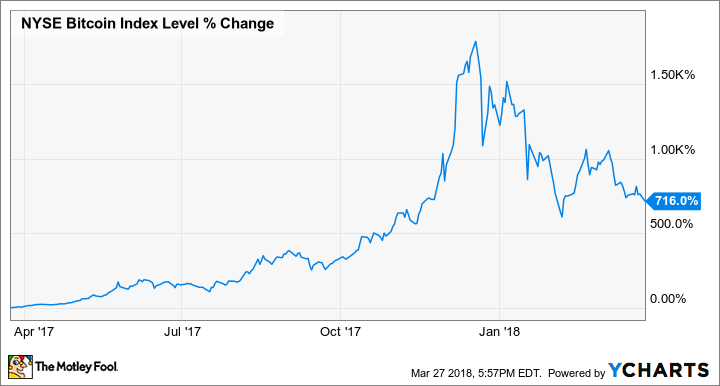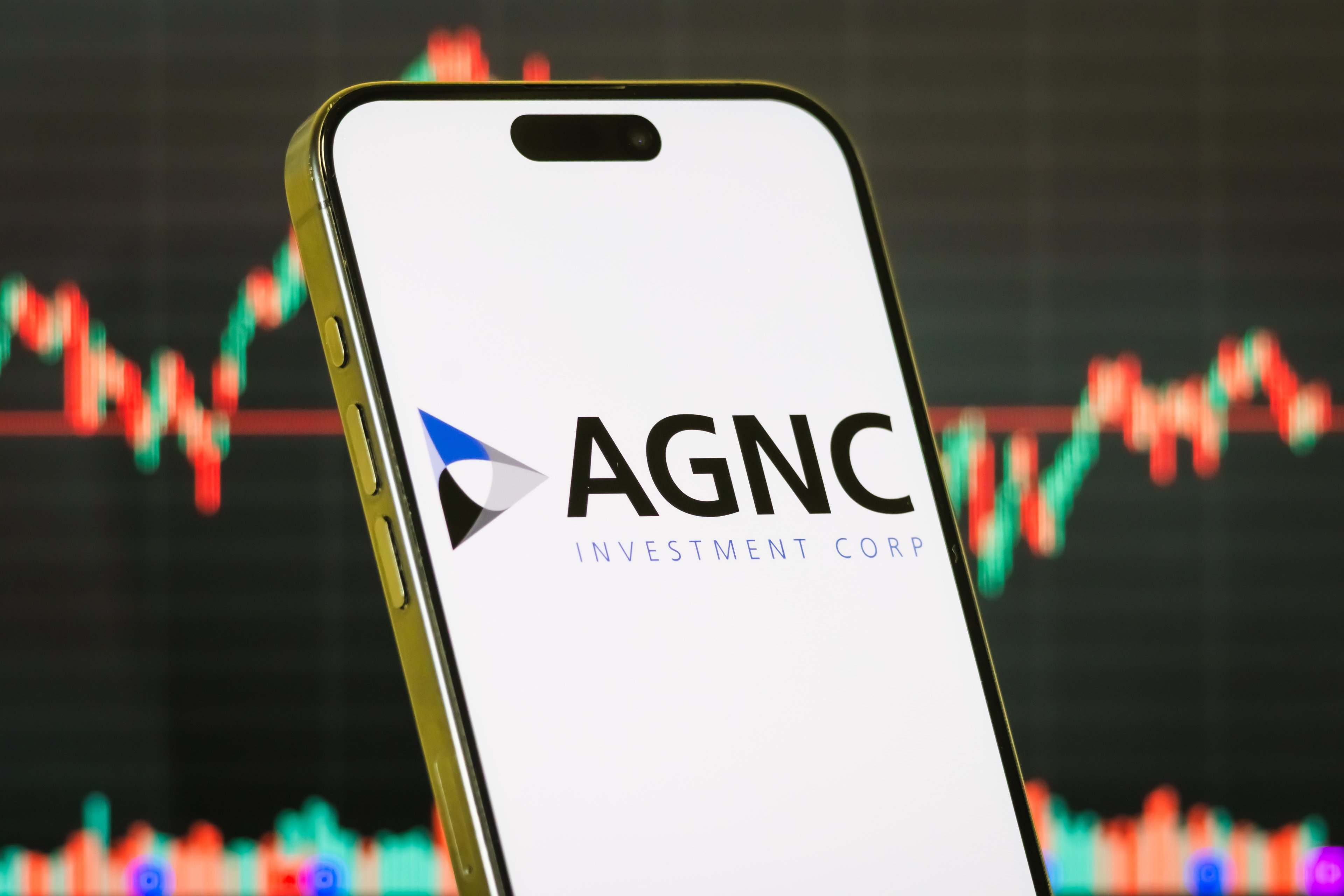One of the biggest financial stories of the past year has been the incredible rise of bitcoin. The virtual currency was designed to revolutionize peer-to-peer transactions; it doesn't require a go-between (like a bank or credit card network), the exchange of personal information, or transaction fees.
Yet while many are still confused about what exactly a "bitcoin" is and how the nascent cryptocurrency works, just as much confusion exists about where bitcoin came from and how it got to where it is today -- a technological innovation that has shaken the financial world to its core.

While no one knows what the future has in store for bitcoin, the cryptocurrency's past is just as mysterious for many investors. Image source: Getty Images.
A bitcoin primer
The backbone of bitcoin is the blockchain technology it uses to record the transactions on its network. A blockchain is essentially a publicly distributed ledger; it records each and every bitcoin transaction ever made on a block. When that block's memory is full, it is added (in sequential order) to the chain of blocks. This ledger -- freely available on any computer in the bitcoin network -- validates bitcoin transactions, stores the blockchain, and relays transactions to other network computers. These computers are called nodes.

Blockchain technology is a publicly distributed ledger that records every single bitcoin transaction. Image source: Getty Images.
Because the database is stored on a network of computers, rather than on a single server, hacking or stealing bitcoin data is virtually impossible for would-be cybercriminals. A hacker would have to break into the majority of nodes simultaneously, a virtually impossible task.
There is also only a predetermined number of bitcoins that can ever be created, meaning that the currency cannot be devalued in the future by a central bank issuing more.
Thanks to the claimed advantages of the cryptocurrency, the only thing that has risen faster than the number of bitcoin enthusiasts is the price of a bitcoin token. Twelve months ago the price of one bitcoin was approximately $1,040. As I write, the price is just under $8,200 -- a 680% increase in just one year.
Satoshi Nakamoto and the mysterious origin of bitcoin
In late 2008, the financial crisis was in full swing. In September of that year, Lehman Brothers Holdings, then the fourth-largest investment bank in the world, filed for Chapter 11 bankruptcy protection. As the world's financial infrastructure was crumbling, the domain bitcoin.org was registered. Later in 2008, a person or group using the pseudonym Satoshi Nakamoto published a white paper on bitcoin to a cryptography mailing list, explaining how the cryptocurrency would work.
In early 2009, Nakamoto mined the first-ever bitcoin, known as the "genesis block." Embedded in the programming of this first bitcoin was the text "The Times 03/Jan/2009 Chancellor on brink of second bailout for banks." The text refers to a headline on that date from the British newspaper The Times, and is generally seen as proof of the date bitcoin was first mined. Others also believe it pointed to the crumbling financial infrastructure of the modern world, and the need for a new way forward. The first bitcoin transaction soon followed, when a bitcoin was sent from Nakamoto to Hal Finney, a cryptography expert and enthusiast.
To this day, Satoshi Nakamoto's identity remains a mystery. Several people have claimed to be the mysterious programmer or, as often suspected, a group of programmers; numerous attempts have been made to identify the person or group, but none have been satisfactory enough to be viewed as conclusive. The only personal details that Nakamoto gave to others were claims to be living in Japan and to have been born April 5, 1975. Nakamoto encouraged other cryptographers to assist with the coding, but the creator stepped away from bitcoin in 2011 and has not been publicly seen or heard from since. As we will soon see, Satoshi Nakamoto is not the only infamous alias in the annals of bitcoin.
From pizza to Silk Road

The first ever bitcoin transaction involved the purchase of two pizzas for a Florida programmer. Image source: Getty Images.
In May 2010, a Florida programmer named Laszlo Hanyecz offered 10,000 bitcoins in exchange for pizza. A British enthusiast took Hanyecz up on the offer and ordered two pizzas to be delivered from a pizza place near Hanyecz's residence; the Briton paid for the pizza using a credit card, and Hanyecz reimbursed the purchase with 10,000 bitcoins. This is believed to be the first time bitcoin was ever used to make a purchase, and May 22 is celebrated in the bitcoin community as Bitcoin Pizza Day. What makes the transaction even more memorable, however, is the incredible value the bitcoins used to purchase two pizzas have accrued. As I write, those bitcoins are worth approximately $90,000,000! That's a lot of dough.
While the pizza purchase is celebrated, in bitcoin's early days very few places of business accepted bitcoin as payment. One area where bitcoin's anonymous nature and digital movement were prized, however, was the black market. It quickly became apparent that bitcoin filled a huge need in the criminal underworld.
In 2011, an online dark-web marketplace dubbed Silk Road was founded by Ross Ulbricht, who ran the site using the pseudonym Dread Pirate Roberts. The use of Tor routers (so users could browse in anonymity) and untraceable bitcoin payments proved to be a potent combination to avoid detection and arrests by law enforcement. In founding the site, Dread Pirate Roberts claimed libertarian ideals, saying customers would be free to purchase anything without fear of violence or arrest. Later, he wrote that he wanted Silk Road "to grow into a force to be reckoned with that can challenge the powers that be and at last give people the option to choose freedom over tyranny."
While his intentions might have been noble, the site freely allowed all sorts of illegal drugs to be bought and sold with impunity. In October 2014, almost 14,000 product listings on Silk Road were found to be illegal drugs, including cannabis, heroin, LSD, MDMA, and methamphetamine. Other illegal items like fake driver's licenses could also be purchased, though categories like child pornography and weapons were banned from the site.

Bitcoin fills a need in the criminal underworld because it allows criminals to move money both digitally and anonymously. Image source: Getty Images.
Before Ulbricht was found and arrested, Silk Road had over a million active user accounts and had accounted for 1.2 million transactions worth 9.5 million bitcoins. While the price of bitcoin fluctuated wildly during the time of the site's operation, the total was estimated to be worth about $1.2 billion.
An intensive search was conducted by a joint task force that included agents from the FBI, Internal Revenue Service, Drug Enforcement Administration, and U.S. Marshals; they finally found Ulbricht to be the man behind the site, and arrested him at a San Francisco public library in October 2013. While Silk Road was shut down, cryptocurrencies remain popular in black markets, as they offer buyers and sellers a cloak of anonymity without the limitations of using large amounts of cash.
Bitcoin billionaires
In March 2013, the value of all bitcoins in circulation hit $1 billion. While this was an arbitrary milestone, it was probably not a coincidence that the cryptocurrency soon started attracting the attention of Silicon Valley and venture capitalists. The best-known of these early investors may be the Winklevoss twins.

Tech-savvy businesspeople soon moved in and invested in bitcoin and other cryptocurrencies. Image source: Getty Images.
Cameron and Tyler Winklevoss are probably better known for filing a lawsuit claiming that while they were all students at Harvard University, Facebook founder Mark Zuckerberg stole their idea for the social networking site; they ultimately received a $65 million settlement. The twins insisted on collecting the lawsuit's settlement in shares of Facebook, not cash. When Facebook went public, the twins used that money to begin amassing a fortune in bitcoin, estimated to be worth approximately $1.3 billion late last year. The Winklevosses are also majority owners in Gemini, a virtual currency exchange they founded after realizing how difficult it was to buy and sell bitcoin.
The rise and fall of Mt. Gox
In 2006, the website Mt. Gox was launched by programmer Jeb McCaleb for fans of the fantasy card game Magic: The Gathering ("Mt. Gox" stood for "Magic: The Gathering Online eXchange.") McCaleb never gave the site much attention until 2010, when he decided bitcoin users needed an online exchange to buy and sell the cryptocurrency. The site took off; in early 2011, McCaleb sold it to Mark Karpeles, a French developer living in Japan.
Almost from the moment Karpeles took over the site's operations, to its inglorious end a few years later, the exchange was plagued with operating deficiencies, security breaches, and negligence. These incidents included:
- June 2011: A security breach fraudulently decreased the price of bitcoin on Mt. Gox.
- October 2011: More than 2,500 bitcoins were sent to invalid addresses, causing them to be lost forever, since no private keys could be assigned to them.
- April 2013: Mt. Gox suspended trading for a market cooldown because bitcoin's price was rising too rapidly. During the shutdown, the price of bitcoin worldwide dropped below $55, before rebounding to levels above $100.
- May 2013: Mt. Gox was sued by CoinLab for breach of contract, for failing to allow CoinLab to handle its North American operations.
- June 2013: Mt. Gox suspended withdrawals in U.S. dollars. The next month, the site said it would again allow withdrawals in U.S. currency, but some users reported delays of weeks or months for withdrawals to clear.
- February 2014: Mt. Gox halted all bitcoin withdrawals. A CoinDesk poll during this time found that more than two-thirds of Mt. Gox customers were waiting for a withdrawal; more than a fifth of customers had been waiting for more than three months. By the end of the month, Mt. Gox would file for bankruptcy protection in Tokyo.
After the company filed for bankruptcy, it claimed to have lost more than 750,000 of its account holders' bitcoins and 100,000 of its own -- an incredible 7% of all bitcoins in circulation at the time. During this period the price of bitcoin declined 36%. At its peak, the exchange had facilitated approximately 70% of all bitcoin trading worldwide.
Bitcoin's growing acceptance and present-day resilience
Despite all these troubles, and an early association with illegal activities, bitcoin's rise as a currency is unparalleled in human history. It is not issued as a monetary unit by any country in the world, nor does it contain any tangible or intrinsic value. Yet not only has its price skyrocketed, it is increasingly used as a medium of exchange by individuals and merchants all over the world. Today bitcoin can be used to buy a surprising number of goods and services: gold, real estate, guns (legally), and goods from some of the world's largest companies.
Bitcoin's current price may ultimately prove to be in bubble territory. But few of the world's cryptography experts, libertarian dreamers, and successful venture capitalists ever dreamed the cryptocurrency would become what it is today.






